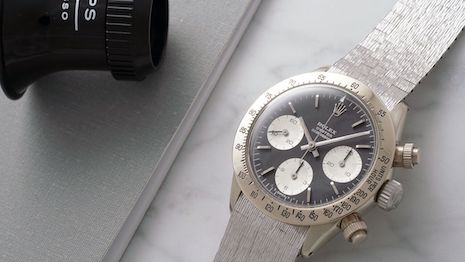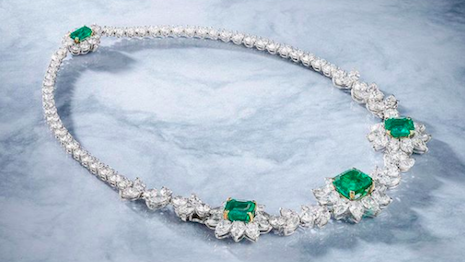 The white gold Rolex Cosmograph Daytona, reference 6265 recently sold to benefit Children's Action. Image courtesy of Phillips
The white gold Rolex Cosmograph Daytona, reference 6265 recently sold to benefit Children's Action. Image courtesy of Phillips
According to a new report from Barnebys, watchmaker Rolex is a dominating force in regards to art, antique and collectible online auction search alerts worldwide.
The research shows that branding is vital in the world of auctions, as consumers will follow beloved labels and artists no matter the price point. While watch brands such as Rolex continue to control online searches, fine art names such as Picasso, Banksy and Koons also have strong presences.
“I think the most interesting thing about the report is the power of branding,” said Pontus Silfverstolpe, cofounder of Barnebys and author of the report. “Even when people cannot afford an artist they follow them - Picasso, Koons and Banky lead this aspirational online behavior - searching the Barnebys Web site for favorite artists.
“The growth of the entry-level market for auctions is also hugely important, up by a third, and of course many of these people will go on to buy valuable items,” he said. “Then there is the love affair with Rolex.
“The Paul Newman watch sale has boosted the level of interest. And finally the predictions based on sales and online searches would indicated that women artists, prints, posters and photography are all headed significantly upwards.”
Auction insights
Barnebys’ report looked at data from more than 65 million lots sold at auction and 16.4 million user sessions relating to 5 million items coming up for sale.
The research showed that customers’ top priorities versus what auctioneers believed their priorities to be only differed in regards to authenticity guarantee. Customers did not include this as a top priority.
 Bonhams hosts more dedicated jewelry sales per year than any other auction house. Image credit: Bonhams
Bonhams hosts more dedicated jewelry sales per year than any other auction house. Image credit: Bonhams
However, this does not mean that customers do not care about authenticity. It shows that they take it for granted and it is a service that has come to be expected.
While branding is important for search, it is also highly influential in terms of consignment, sales results and the competitive landscape for auction houses.
As Rolex is the most searched for brand overall, the watch and jewelry category as a whole is growing in popularity.
Low-end consignment is also pushing the resale industry forward, with items sold priced less than 100 euros, or $115 at current exchange, growing and appealing to younger consumers.
 Phillips' New York auction site. Image credit: Phillips
Phillips' New York auction site. Image credit: Phillips
The report showed that it is not all about the lower priced items. Products sold for between 1,000 and 5,000 euro, or $1,153 and $5,768, have grown by 5 percent.
”What we are seeing now is that the auction market is taking significant market share of luxury brand sales from the peer-to-peer market, private sellers dealing directly with buyers,” Mr. Silfverstolpe said. “Categories like watches, classic cars, vintage clothes and jewels from the major fashion houses and other collectables are becoming increasingly important for the future of the auction market and creating new opportunities for both established auction houses as well as newly launched auction houses.”
Additional insight
After a stagnant few years in the watchmaking industry, younger men are supporting the sector by investing in high-value timepieces through auctions.
Similar to a fine wine or an expensive sports car, men ages 18 to 34 are finding more money to spend and getting in on the ground floor of investments with watches. According to findings from Barnebys, 90 percent of searches on its database are made by men in this age range, and searches by women are growing as well (see more).
Luxury is one of the biggest growth categories for international auction house Christie’s, with the highest proportion of new buyers each year.
This growth rate can be attributed to the growing number of highly wealthy individuals around the world as well as Christie’s own efforts to target affluent consumers. At the auction house’s London Luxury Week, Christie’s is capitalizing on that trend with a host of new products for luxury consumers across the globe (see more).
“A strong rise in the number of items selling in the 1,000 euros to 5,000 euros price bracket reflect a strengthening market across the world, while a big increase in the number of items selling for less than 100 euros points to a greater focus on low-value consumer products, such as furnishings, perishable goods and toys that have not previously had much of an impact in this sphere,” Mr. Silfverstolpe said.